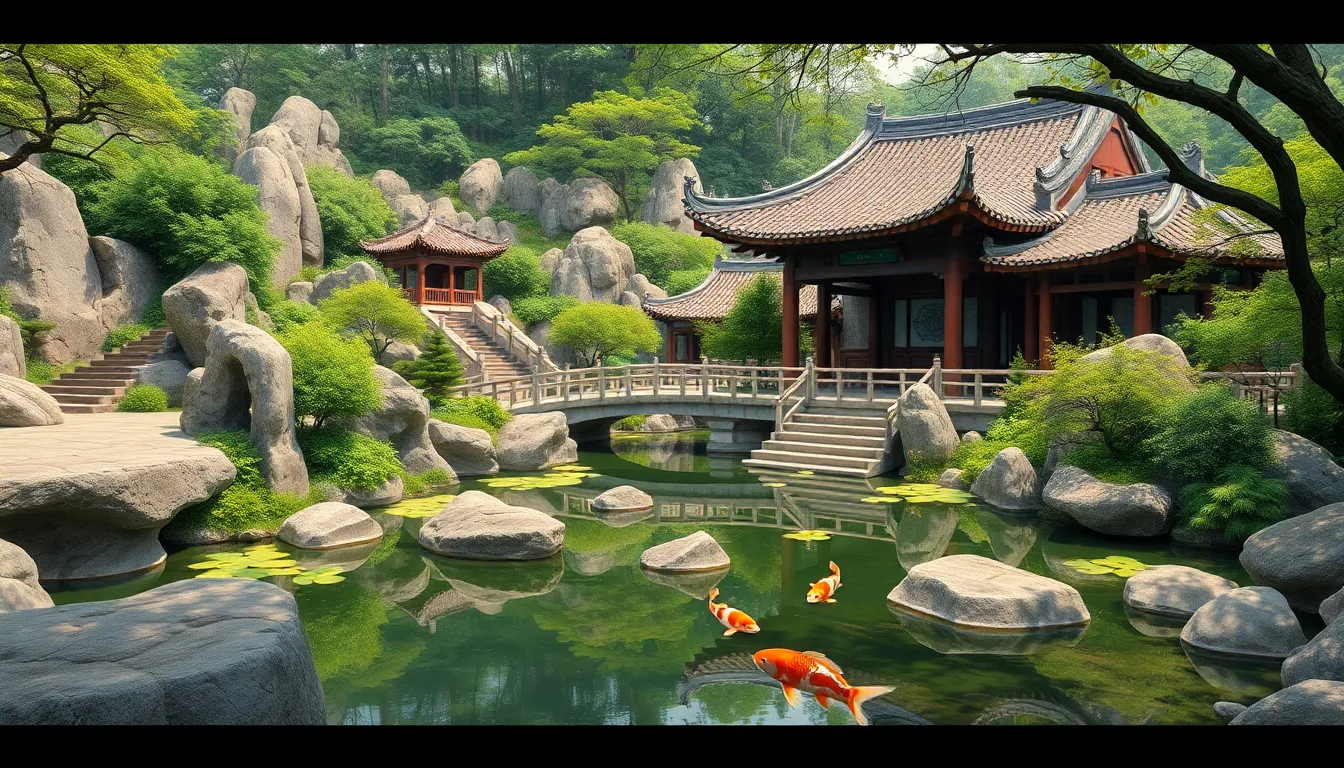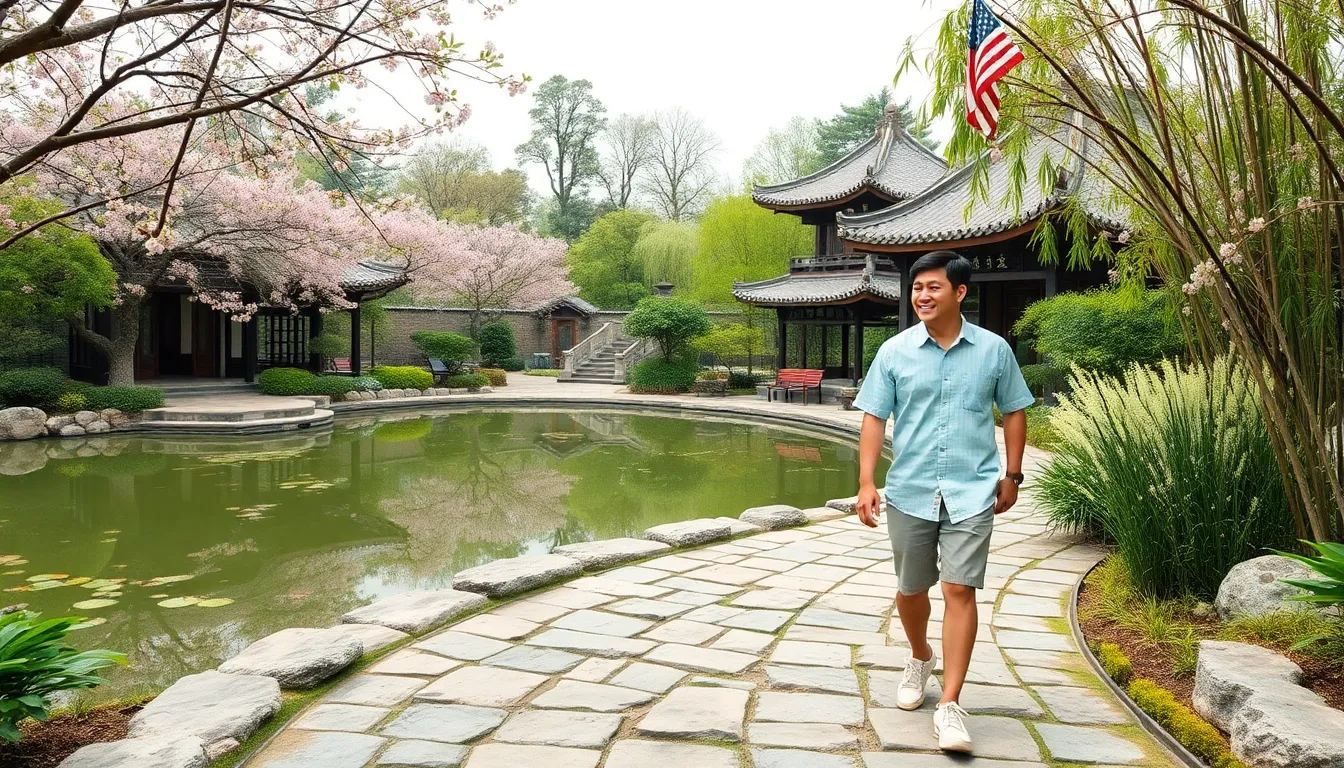Table of Contents
ToggleImagine stepping into a world where tranquility meets vibrant culture, all without a passport. A Chinese cultural garden offers a delightful escape, blending stunning landscapes with rich traditions. It’s like a mini-vacation that transports visitors to ancient China, complete with serene ponds, intricate pathways, and lush greenery.
Overview of Chinese Cultural Gardens
Chinese cultural gardens represent traditional landscapes that reflect philosophical and artistic principles. These gardens often incorporate elements like water, rocks, and plants to symbolize harmony between nature and humanity. Visitors frequently find themselves immersed in classic Chinese artistry, seen in the intricate designs of pathways and structures.
Well-designed gardens include features such as pagodas, bridges, and tranquil ponds. These features create zones for contemplation and relaxation. Gardens often showcase a variety of plants, including bamboo, cherry blossoms, and lotus flowers, each carrying symbolic meanings within Chinese culture.
Specific layouts incorporate concepts from Feng Shui, emphasizing the optimal arrangement of elements to promote positive energy. This arrangement aids in creating an inviting atmosphere where visitors can reflect and connect with nature. Seasonal changes within the gardens also highlight the beauty of evolution, offering unique experiences throughout the year.
Cultural events often take place in these gardens, celebrating festivals and traditions. Lantern festivals, tea ceremonies, and art exhibitions provide glimpses into Chinese heritage, allowing deeper engagement with the culture.
Visitors frequently appreciate the educational aspects of Chinese cultural gardens, offering insights into ancient practices and philosophies. Guided tours often enhance the experience by providing explanations of historical significance and garden design principles.
Overall, Chinese cultural gardens serve as peaceful retreats that seamlessly blend nature with cultural elements, making them a valuable destination for those seeking tranquility and a deeper understanding of Chinese traditions.
History of Chinese Cultural Gardens

Chinese cultural gardens possess a rich history that reflects centuries of tradition and philosophy. These gardens originated over 2,500 years ago, initially designed for emperors and scholars.
Origins and Development
During the Zhou Dynasty, the earliest gardens intended for leisure and reflection emerged, focusing on natural beauty and harmony. The Han Dynasty witnessed garden expansion, featuring complex layouts and symbolic elements. Gardens evolved further during the Tang and Song Dynasties, becoming popular among the elite. Scholars integrated arts and poetry into garden design, emphasizing aesthetic value alongside functionality. By the Ming and Qing Dynasties, private gardens flourished, characterized by elaborate rockeries, ponds, and meticulously arranged plants.
Influences on Garden Design
Philosophical principles significantly influenced the design of Chinese gardens. Confucianism emphasized order and hierarchy, while Daoism encouraged a harmonious relationship with nature. Feng Shui principles guided the layout, enhancing balance and energy flow. Various elements, like winding paths and tranquil water features, created serene environments. Local flora and unique geographical features further shaped individual gardens, reflecting regional characteristics. The blend of spirituality with artistic expression attracted admiration and respect, cementing these gardens’ role in Chinese cultural identity.
Key Elements of Chinese Cultural Gardens
Chinese cultural gardens exhibit distinct elements that enhance their beauty and philosophical significance. Key features include architecture, structures, and symbolic plants.
Architecture and Structures
Pagodas, bridges, and tea houses symbolize traditional Chinese architecture in these gardens. Unique roofs and intricate designs contribute to aesthetic appeal. Pathways weave through the landscape, guiding visitors to serene spots. Each structure integrates with natural surroundings, promoting harmony. Stone lanterns and benches provide places for contemplation. The architecture fosters tranquility and invites exploration, creating a holistic experience of beauty.
Symbolic Plants and Flowers
Plants selected for Chinese cultural gardens carry deep meanings. Bamboo represents flexibility and resilience, while cherry blossoms symbolize the fleeting nature of life. Other significant plants include lotus, embodying purity, and pine trees, representing longevity. The variety of flora enriches the garden’s aesthetic and cultural layers. Seasonal blooms offer a dynamic view, emphasizing the cycle of life. Each plant enhances the garden’s identity and invites reflection.
Cultural Significance of Chinese Gardens
Chinese gardens carry immense cultural significance, representing harmony between nature and human existence. These gardens embody ancient traditions, deep philosophies, and aesthetic values through their design and layout.
Philosophical Underpinnings
Confucianism and Daoism lay the groundwork for Chinese garden design. Confucianism emphasizes order, balance, and moral integrity, guiding the spatial arrangement and selection of elements. Daoism promotes a connection to nature, encouraging gardens to reflect natural landscapes. In these serene spaces, rocks, water, and plants symbolize life’s cyclical nature, illustrating the beauty of harmony. Through thoughtful landscape planning, gardens mirror philosophical principles, inviting visitors to experience tranquility and contemplation.
Festivals and Events Celebrated
Numerous festivals and events enliven Chinese gardens throughout the year. During the Lunar New Year, celebrations include lantern displays and calligraphy, adding vibrancy to the garden setting. The Mid-Autumn Festival highlights moon appreciation with gatherings under the full moon while enjoying traditional mooncakes. Similarly, the Qingming Festival draws families for ancestral remembrance, with picnics amidst blooming flowers. Each event enriches the cultural tapestry of the garden, offering visitors an immersive experience in tradition and community.
Famous Chinese Cultural Gardens Around the World
Chinese cultural gardens exist globally, showcasing the beauty of classical design and philosophy. Their unique features attract visitors seeking tranquility and a deep connection to tradition.
Notable Gardens in the United States
The Huntington Library, Art Museum, and Botanical Gardens in California features a stunning Chinese Garden known for its intricate landscape design. This garden incorporates traditional elements like a koi pond and ancient rock formations. Another gem, the Chinese Garden at the Portland Classical Chinese Garden in Oregon, serves as an authentic representation of Chinese gardening principles. Visitors enjoy the peaceful environment created by traditional structures, water features, and a diverse range of foliage.
Iconic Gardens in China
Suzhou gardens rank among the most famous in China, known for their exquisite artistry and historical significance. The Humble Administrator’s Garden exemplifies Ming Dynasty design, featuring waterways and elegant bridges. In Hangzhou, the West Lake Cultural Landscape highlights picturesque gardens with scenic views and cultural landmarks. Additionally, the Lingering Garden in Suzhou, celebrated for its classical architecture and harmonious layout, showcases the intricate relationship between nature and artistry in Chinese garden design.
Visiting a Chinese cultural garden offers a unique opportunity to connect with ancient traditions and philosophies. The serene landscapes and thoughtfully designed elements create a retreat that encourages reflection and relaxation. Each garden tells a story through its architecture and plant life, inviting visitors to explore the harmonious relationship between nature and humanity.
These gardens not only showcase the beauty of traditional Chinese design but also serve as cultural hubs where community and celebration thrive. Whether it’s through seasonal blooms or festive events, the experience is enriched by the deep-rooted significance of each element. Embracing the tranquility of a Chinese cultural garden can inspire a greater appreciation for the art of living in harmony with nature.








